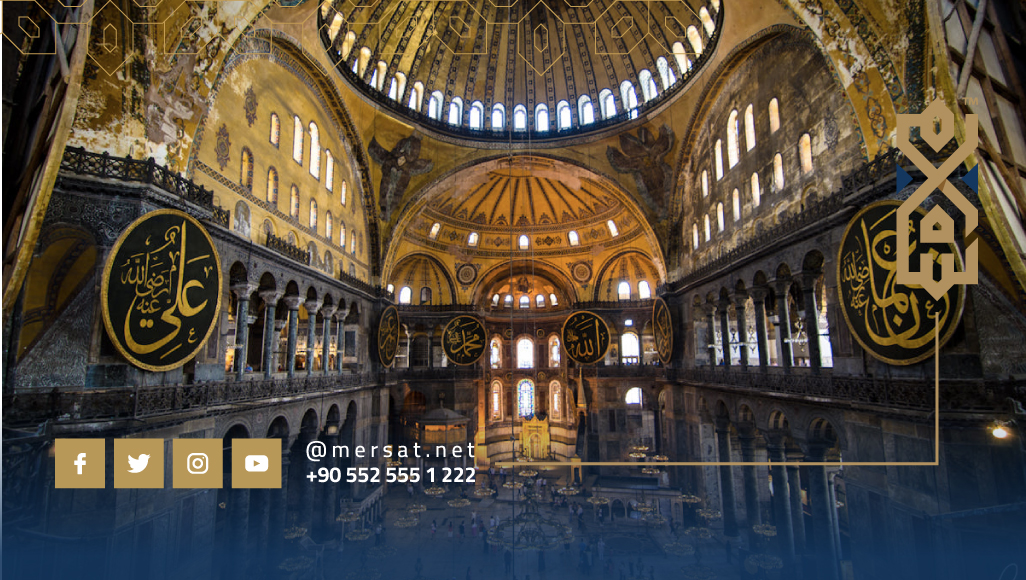
Hagia Sophia .. church, mosque and museum, what is the story of Hagia Sophia?
Last Updated: 2023-07-27Hagia Sophia Mosque
Not just a beautiful building that Istanbul is famous for, the domes and walls of the Hagia Sophia building carry a long history crowded with tales and arts, in a prominent place on the banks of the Bosphorus next to the Sultanahmet Mosque, and it is one of the most visited museums across the world.
What is the secret of the name Hagia Sophia?
It was initially called Megali Aclicia (the great church) and then after the fifth century it was called Hagia Sophia (the place of holy wisdom), hence the name "Hagia Sophia".
Once upon a time... Hagia Sophia throughout history
In the sixth century AD, Emperor Constantine built the church for the first time, but it was later burned down during riots and rebellion, so Emperor Justinian ordered to build it again in 532 AD, then 10,000 workers participated in the construction and it took 5 years, it represented then an unparalleled religious architectural symbol, so it was an important indication of the power of the Eastern Roman state and became a place for the coronation of all Byzantine rulers since the seventh century AD.
With the Ottomans taking power and conquering Constantinople in 1453, the Ottoman Sultan Mehmed the Conqueror announced the conversion of the Hagia Sophia building into a mosque and ordered to cover the mosaic drawings inside without removing them, then the walls were decorated with writings of Ottoman calligraphers, and four cylindrical minarets were added in the Ottoman style and they placed a group of Quranic paintings, in addition to four huge circular writing panels at the top of the four main columns and in the belly of the dome from the side of the mihrab, on which words were written)) Allah, Muhammad, Abu Bakr, Umar, Uthman, and Ali.
In 1935, Mustafa Kemal Ataturk ordered the conversion of the Hagia Sophia Mosque into a museum, which has been on the World Heritage List since 1985 and is the second most attractive Turkish museum for tourists.
A building that speaks in detail
The building combines the most beautiful of Byzantine architecture and Ottoman architecture, as the building was built in the basilica style, in a rectangular shape with a length of 76 meters from east to west and 72 meters from north to south, and the grand dome is located above the center of the building and rises from the ground between 60 and 55 meters and includes 40 windows.
The walls are decorated with marble panels of various types and colors, the ceilings are decorated with wonderful views of fresco and mosaics, and the floors are covered with colored mosaic tiles with attractive geometric designs.
Historians state that Emperor Justinian used about 150 tons of gold in the construction of Hagia Sophia.
What does the exterior section of the Hagia Sophia building include
Five tombs of Ottoman sultans (Selim II, Murad III, Mehmed III, Mustafa I and Ibrahim), in addition to a primary school built by Sultan Mahmud I in 1740, and turned in 2010 into a center for documentation, photography and research and a hall for exhibitions and activities associated with the museum, and the external section contains the waterfall and ablution taps, the temporary room, minarets, external supports, treasury building, the house of the poor, the Fatih School, in addition to a huge fountain built by Sultan Mahmud I and is one of the largest fountains in Istanbul, on a dome supported by 8 Columns, from which bronze taps emerge, and Islamic inscriptions appear.
What does the internal section include:
The central dome of Hagia Sophia, paintings and mosaic drawings, calligraphy panels, mihrab, pulpit, Sultan's room, muezzin room, Mahmud I library, marble jars, wish column, emperor's gate and some other sections.
Does it carry the identity of a church, a mosque or a museum? Is all that.. Hagia Sophia has undergone remarkable transformations over time, from the first stone to fires, earthquakes, and changes, but what has been constant since its inception until now is its role, its great position, and its embrace of the ancient heritage of the region.
The Hagia Sophia Museum is open to visitors from Tuesday to Sunday from 9:30 a.m. to 4:30 p.m.
Editorial Mersat Real Estate Team©
